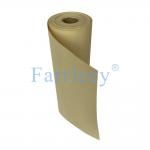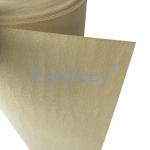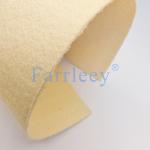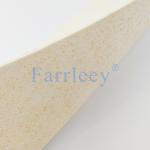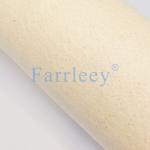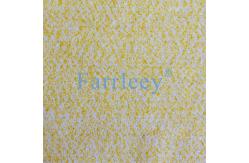Advanced Filtration Material Aramid Nonwoven Fabric For Cement Kiln
Dust Filtration
Aramid nonwoven fabric is an advanced filtration material widely
used in cement kiln dust collection systems, particularly for
cement kilns' kiln head and kiln tail. Known for its exceptional
high-temperature resistance, high strength, and excellent
filtration efficiency, Aramid nonwoven fabric is an ideal solution
for filtering harmful dust and gases emitted from cement
manufacturing processes. It helps reduce emissions, improve air
quality, and ensure compliance with environmental regulations.
Key Features and Advantages of Aramid Nonwoven Fabric in Cement
Kiln Dust Filtration:
Outstanding High-Temperature Resistance: Aramid nonwoven fabric can
withstand continuous temperatures of up to 260°C, making it perfect
for the high-temperature environment of cement kilns, both at the
kiln head (where gases are hot) and the kiln tail (where exhaust
gases are still heated).
Superior Strength and Durability: Aramid fibers, such as Kevlar and
Nomex, are known for their high tensile strength and tear
resistance. This makes Aramid nonwoven fabric extremely durable
under the constant stress of high-velocity gas flows and abrasive
dust particles in cement plants.
Effective Dust Filtration: The fabric offers excellent filtration
efficiency for fine particulate matter and dust (PM10, PM2.5)
generated during cement production. This is critical for reducing
harmful emissions and improving air quality around cement kilns.
Chemical and Abrasion Resistance: Aramid nonwoven fabric is
resistant to many chemicals, including acids and alkalis commonly
found in cement plant emissions. Its resistance to abrasion also
helps maintain the material’s integrity in challenging
environments.
Technical Parameters:
Material: Aramid fibers (e.g., Nomex, Kevlar)
Temperature Resistance: Up to 260°C (500°F)
Filtration Efficiency: >99% for fine particulate matter (PM2.5,
PM10)
Thickness: 0.3 mm to 1.2 mm, depending on specific application
needs
Air Permeability: 100 to 500 L/m²/s, depending on fabric thickness
Surface Treatment: Optional surface coatings (e.g., PTFE coating)
for enhanced dust release
Applications in Cement Kiln Dust Filtration:
Kiln Head Dust Filtration: At the kiln head, where gases can reach
temperatures above 200°C, Aramid nonwoven fabric is used to capture
fine particulate dust before it is released into the atmosphere.
The fabric ensures that particulate emissions are kept well below
regulatory limits.
Kiln Tail Exhaust Filtration: At the kiln tail, where the gas
temperature is lower but still challenging, Aramid nonwoven fabric
helps filter out remaining dust and contaminants from exhaust
gases. This contributes to a cleaner production process and reduces
environmental pollution.
Pollution Control Systems: In cement manufacturing, Aramid nonwoven
fabric is widely used in baghouse filters and other air pollution
control systems to ensure effective capture of dust, smoke, and
harmful particles, helping cement plants meet strict emission
standards.
Frequently Asked Questions (FAQ):
Q1: What makes Aramid nonwoven fabric ideal for cement kiln dust
filtration?
A1: Aramid nonwoven fabric is ideal for cement kiln applications
because of its excellent high-temperature resistance (up to 260°C),
high strength, and dust filtration efficiency, all of which are
critical for handling the tough conditions at cement kilns.
Q2: How long does Aramid nonwoven fabric last in a cement kiln
environment?
A2: Thanks to its durability and abrasion resistance, Aramid
nonwoven fabric lasts longer than many other filtration materials.
Its robust performance in harsh conditions reduces the need for
frequent replacements, making it a cost-effective choice.
Q3: How does Aramid nonwoven fabric help in reducing emissions from
cement kilns?
A3: Aramid nonwoven fabric captures fine particulate matter and
harmful gases produced during cement production, ensuring that the
emissions are filtered and that the plant meets environmental
regulations.
Q4: Can Aramid nonwoven fabric handle the highly abrasive dust in
cement kilns?
A4: Yes, Aramid nonwoven fabric is specifically designed to handle
the abrasive dust in cement plants. Its abrasion resistance ensures
long-term durability even in environments where dust particles can
cause damage to other filtration media.
Why Choose Our Aramid Nonwoven Fabric for Cement Kilns?
At Farrleey Filtration, we provide high-performance Aramid nonwoven
fabric tailored for cement kiln dust filtration. Our materials are
designed to ensure maximum filtration efficiency, high durability,
and long service life in the demanding environment of cement
production. Whether for the kiln head or kiln tail, we offer
solutions that help you meet emissions standards while keeping
maintenance costs low. Contact us today to learn more or request a
custom quote for your specific needs.
